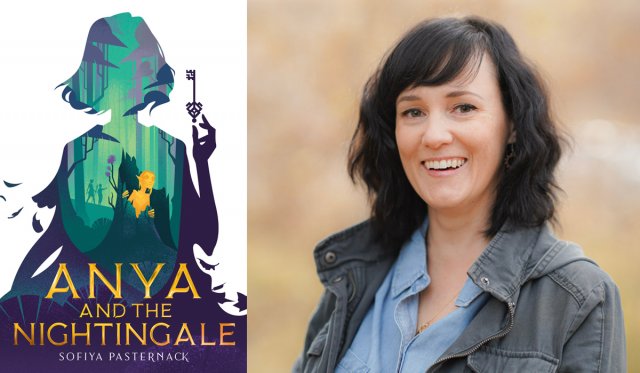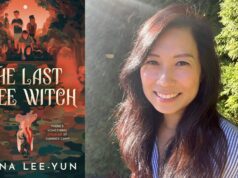
(Editor’s note: NonDoc’s Author Umbrella interviews up-and-coming writers, particularly authors of color, authors of disability and LGBTQ+ authors. The interviews have been transcribed and lightly edited for length and clarity.)
For the latest installment in our Author Umbrella series, I interviewed Sofiya Pasternack, author of the novel Anya and the Nightingale. The book, which received the Sydney Taylor Book Award and was a National Jewish Book Award finalist, is published by Versify, an HMH Books and Media imprint curated by the author Kwame Alexander. Anya and the Nightingale hit bookshelves on Nov. 10, 2020.
Here’s a short synopsis:
The adventure continues in this exciting sequel to Anya and the Dragon; a dangerous monster lurks beneath the city and only Anya can keep him from taking her friends’ magic — and their lives. Perfect for fans of The Girl Who Drank the Moon.
It’s been a year since a violent Viking terrorized the small village of Zmeyreka and Anya and her foolish friend Ivan saved a friendly dragon from being sacrificed for his magic.
But things still aren’t safe in the kingdom of Kievan Rus’.
After embarking on a journey to bring her papa home from war, Anya discovers a powerful forest creature terrorizing travelers. But she soon learns that he’s not the monster the kingdom should fear. There’s an even greater evil that lurks under the city.
Can Anya stop the monster, save her papa, and find her way home? Or will the secrets of Kiev leave Anya and her friends trapped beneath the city forever?
As a hard-of-hearing person, I’m very excited about the introduction of a deaf character in Anya and the Nightingale. Could you tell us a little about the character? What inspired the character’s version of sign language?
Absolutely! Alfhercht is an elf who is very loosely based on the Russian myth of Nightingale the Robber, who was a highwayman who used a lethal whistle to kill people and then steal their stuff. I changed him to be less murdery but still have this sound magic. The way magic works in Anya’s world is by manipulating strings. If you’ve got an affinity for a certain kind of magic, you’ll see the strings associated with it in the air, and when you interact with these strings, you can make things happen. For Alfhercht, he can see the strings of sound, so he can use sound magic to create what are essentially sonic blasts that he can shoot at people.
I wanted him to be visibly deaf, though, so his magic can’t be used as a way to hear what others are saying. He’s been deaf since he was a baby, and his older brother and he developed a type of sign language to communicate. The way I wrote it, it’s described like ASL, because I wanted it to be recognizable to anyone who’s familiar with ASL. I figured if the hearing characters are speaking English, then the deaf characters can speak ASL!
From reading your previous book, Anya and the Dragon, I felt like my biggest takeaway was the importance of young people thinking for themselves and not judging others based on hearsay. What lessons do you hope readers take away from Anya and the Nightingale?
Honestly, Anya and the Nightingale has very much the same message! But it’s put in a much bigger setting now. Before, everything was contained to Anya’s village and she was grappling with something pretty small. She even had her grandmother on her side of the issue! But in Kiev there’s no one on the Nightingale’s side. Anya’s even been a victim of his lashing out. But she has this feeling tickling the back of her mind, and she takes those lessons she learned from her experiences with Håkon and extrapolates them to Alfhercht.
Anya and the Nightingale’ takes place in Russia before it was Russia. There is also this beautiful, diverse backdrop of Christianity, Judaism and ancient magic. What drew you to the setting, and how did the series come to be?
The heart of this story is my very favorite fairy tale, which is actually Scandinavian rather than Slavic. But the two cultures were very much bleeding into one another during this time period, so it worked out! I was also very much influenced by Russian byliny, epic folk songs. The cycle I drew from all involve a mythical Tsar Vladimir and Ivan Tsarevich, the former of which was definitely inspired by the historical figure Vladimir I. He was the ruler who formally converted all of Russia to Christianity, and the byliny of the time period reflect this emphasis on Christian iconography and values. I pulled a lot of the characters and creatures of both books from these epic folk songs, as well as the original Scandinavian story. Håkon is, after all, a Scandinavian name!
In Anya and the Dragon, Anya is a proficient cook. Will she be making any new recipes in ‘Nightingale’?
Anya doesn’t have a ton of opportunity to cook things herself in the second book! Heck, she hardly even has time to eat anything, let alone cook! But she is always ready to bake some challah!
https://twitter.com/sofipasternack/status/1339329414878744576
You have a YouTube channel where you break down the writing process in simple, easy-to-digest videos. As an aspiring writer, my favorite videos have been the schema series, in which you use your mental health background to inform character development. What schema would Anya fall under? And what process did you use to mold her personality?
Woohoo, thanks for watching my videos! Anya is a classic self-sacrificial personality. She’s willing to do things that aren’t great for her personally, in order to benefit others. In her case, she’ll compromise her own very rigid morals in order to ensure her family doesn’t lose their home. She is also willing to forego making any friends in the village in order to appease her grandmother’s paranoia about the other villagers. Anya’s personality is very much based on my own, especially the rigidity and the stubbornness.
What elements of Anya and the Nightingale do you think will most appeal to OKC readers?
Anya, Ivan, and Håkon are a trio of fundamentally different kids who are brought together by strange circumstance, but then become good friends anyway. And I think that’s something that kids anywhere can relate to. Plus, if you’re out near any rivers and you see a weird-looking fish … it might not be a fish at all.
What has been your favorite aspect of writing the Anya series: plot, world-building, character design, theme?
This is a hard question! Because I love all of these for different reasons. I start everything with a theme and build out from there, so hitting on the perfect theme and designing a story around it is a great puzzle to work out. It’s really mentally engaging. World-building is a favorite activity of mine, but it’s secondary to the theme, the story, and the characters. And the characters — well, if you don’t have great characters, then you don’t have much of a story do you?
I think for Anya specifically, the historical world-building was a ton of fun, and it was pretty challenging at times. So, I’m going to pick that one for now!





















